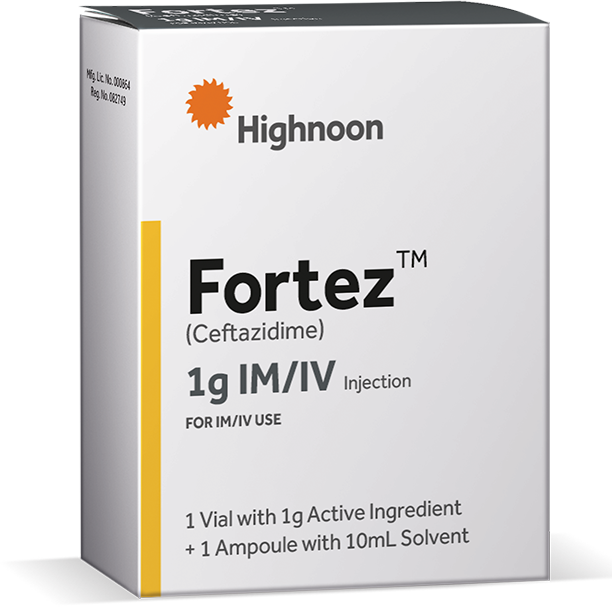Fortez (500mg, 250mg, 1g)
Brand Name
Fortez
Generic Name
Fortez
Composition
Fortez 250mg IM/IV Injection: Each pack contains:
Vial: Ceftazidime Pentahydrate equivalent to Ceftazidime
250mg (with Sodium Carbonate)
Ampoule: Sterile water for injection USP 5mL
Fortez 500mg IM/IV Injection: Each pack contains:
Vial: Ceftazidime Pentahydrate equivalent to Ceftazidime 500 (with Sodium Carbonate)
Ampoule: Sterile water for injection USP 5mL
Fortez 1g IM/IV Injection: Each pack contains:
Vial: Ceftazidime Pentahydrate equivalent to Ceftazidime 1g
(with Sodium Carbonate)
Ampoule: Sterile water for injection USP 10mL
Fortez 2g IV Injection: Each pack contains:
Vial: Ceftazidime Pentahydrate equivalent to Ceftazidime 2g
(with Sodium Carbonate)
Ampoule: Sterile water for injection USP 10mL
Description
Fortez contains Ceftazidime, a semisynthetic, third generation, broad-spectrum, beta-lactam antibacterial drug for parenteral administration.
Indications
Fortez (Ceftazidime) is indicated for the treatment of patients with infections caused by susceptible strains of the designated organisms in the following diseases:
1. Bacterial Septicemia caused by Pseudomonas aeruginosa, Klebsiella spp., Hemophilus influenzae, Escherichia coli, Serratia spp., Streptococcus pneumoniae, and Staphylococcus aureus (methicillin-susceptible strains).
2. Bone and Joint Infections caused by Pseudomonas aeruginosa, Klebsiella spp., Enterobacter spp., and Staphylococcus aureus (methicillin-susceptible strains).
3. Gynecologic Infections, including endometritis, pelvic cellulitis, and other infections of the female genital tract caused by Escherichia coli.
4. Intra-abdominal Infections, including peritonitis caused by Escherichia coli, Klebsiella spp., and Staphylococcus aureus (methicillin-susceptible strains) and polymicrobial infections caused by aerobic and anaerobic organisms and Bacteroides spp. (many strains of Bacteroides fragilis are resistant).
5. Central Nervous System Infections, including meningitis, caused by Haemophilus influenzae and Neisseria meningitidis. Ceftazidime has also been used successfully in a limited number of cases of meningitis due to Pseudomonas aeruginosa and Streptococcus pneumoniae.
6. Prophylaxis for transurethral resection of prostate
7. Lower Respiratory Tract Infections, including pneumonia, caused by Pseudomonas aeruginosa and other Pseudomonas spp.; Hemophilus influenzae, including ampicillin-resistant strains; Klebsiella spp.; Enterobacter spp.; Proteus mirabilis; Escherichia coli; Serratia spp.; Citrobacter spp.; Streptococcus pneumoniae; and Staphylococcus aureus (methicillin-susceptible strains).
8. Post-surgical Infections caused by Pseudomonas aeruginosa; Klebsiella spp.; Escherichia coli; Proteus spp., including Proteus mirabilis and indole-positive Proteus; Enterobacter spp.; Serratia spp.; Staphylococcus aureus (methicillin-susceptible strains); and Streptococcus pyogenes (group A beta-hemolytic streptococci).
9. Urinary Tract Infections, both complicated and uncomplicated, caused by Pseudomonas aeruginosa; Enterobacter spp.; Proteus spp., including Proteus mirabilis and indole positive Proteus; Klebsiella spp.; and Escherichia coli.
10. Febrile neutropenia
11. Susceptible infections due to sensitive Gram-positive and Gram-negative bacteria, caused by pseudomonas species
It may be used alone in cases of confirmed or suspected sepsis. it may also be used concomitantly with other antibacterial drugs, such as aminoglycosides, vancomycin, and clindamycin; in severe and life-threatening infections; and in the immunocompromised patient. When such concomitant treatment is appropriate, prescribing information in the labeling for the other antibacterial drugs should be followed. The dose depends on the severity of the infection and the patient’s condition.
To reduce the development of drug-resistant bacteria and maintain the effectiveness of Fortez and other antibacterial drugs, Fortez should be used only to treat infections that are proven or strongly suspected to be caused by susceptible bacteria. When culture and susceptibility information are available, they should be considered in selecting or modifying antibacterial therapy. In the absence of such data, local epidemiology and susceptibility patterns may contribute to the empiric selection of therapy.
Presentation
FORTEZ 2G IM/IV INJECTION:
Vial containing powder and ampoule with 10mL water for injection
FORTEZ 1G IM/IV INJECTION:
Vial containing powder and ampoule with 10mL water for injection
FORTEZ 500MG IM/IV INJECTION:
Vial containing powder and ampoule with 5mL water for injection
FORTEZ 250MG IM/IV INJECTION:
Vial containing powder and ampoule with 10mL water for injection







